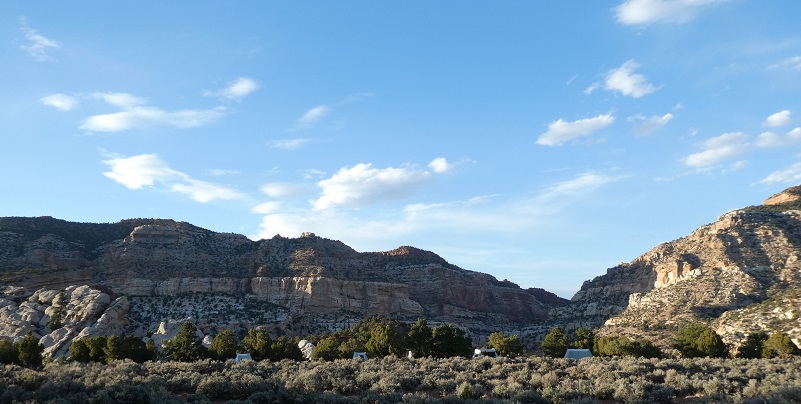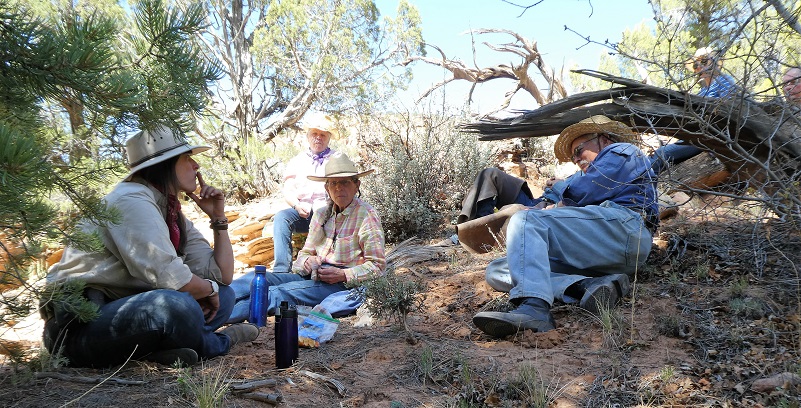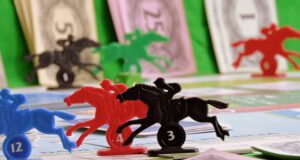Whatever you have wanted to ask about my recent horse camping trip with Hondoo Rivers and Trails but were afraid to ask is what this blog is all about.
We sure did ride across some beautiful country in Utah’s Capitol Reef National Park and adjoining lands but there it takes a lot to make this happen. I cannot begin to address the planning and logistics that Hondoo Rivers and Trails did to prepare for this trip but I can share my thoughts and experiences with you.
What does a well dressed want to be cowgirl wear to a week long camping and horseback trail ride? I wore long sleeved shirts with a short sleeved T-shirt underneath. I also wore chinks over my Wrangler jeans and gloves. Chinks are similar to chaps but are shorter. Chaps run the full length of the rider’s legs, protecting your legs against the sticky and pokey things that you encounter on the trail. Both chinks and chaps are buckled around the waist, and are open in the back so a rider’s seat is not covered. I figured that we had some brushy country to ride in and they would be beneficial. Plus, they make me feel like a cowboy riding in the old west. I am sure glad I wore mine because we rode through pretty heavy brush and trees and with my long sleeves and chinks, I didn’t get a scratch on me. Sorry I didn’t take a picture of the brushy spots but I was busy guiding my horse through them and not getting whacked. My hands also didn’t dry out as much and still look mighty pretty since I wore those gloves. I also brought a pair of shorts and camp shoes to change into after the ride.
This is the tent that I stayed in during the week. I paid a single supplement to have my own tent and it is always worth the small amount to me. That single tent is not huge though and it helps to be organized so you don’t need to wade through your stuff to get to your bed. Since I had been on a horse camping trip with them before, I brought a few luxury items to make my stay more comfortable. Although they provide sleeping bags, I brought my own this time and it worked perfectly on the cot, foam mattress and blow up mattress that they provided. I brought a loop rope bungee cord to store more items above. I also brought a solar light for the tent, in addition to a head lamp and small flashlight. I also brought a door mat to kick the dust off before getting into the tent. The door mat was actually an old kitty litter mat but it worked like a charm and kept the tent cleaner.
And this was the view from the back of my tent.
 We had a shower, which I used mid week. They heated up water and filled up the white bucket, which you could control the output with a spigot at the bottom of the bucket. It worked perfectly and washing my hair made me feel like a whole new woman. Each morning and night, they had a wash basin that I used for a spit bath. And those baby wipes that I brought with me came in handy.
We had a shower, which I used mid week. They heated up water and filled up the white bucket, which you could control the output with a spigot at the bottom of the bucket. It worked perfectly and washing my hair made me feel like a whole new woman. Each morning and night, they had a wash basin that I used for a spit bath. And those baby wipes that I brought with me came in handy.
Now, a little bit about the horses. Most of these horses have been bred and raised by Patricia Kearney and her husband Gary George. These horses are used to the trail and the arid condition in Utah. They are sure footed and a pleasure to ride. We watered them throughout the day when we had good water, plus they were watered morning and night in a nearby creek. Below is Cody, one of our two wranglers plus one of the owners. They took good care of the horses and also took good care of us.
After they were unsaddled, they were tied on a highline for the evening and night.
We sat around under the shade of the juniper trees, having a snack and cold drink. The gnats would buzz around our heads and it took us two days to figure out that they were biting us. We finally got smart and moved out from the shade and those gnats didn’t bother us after that. The gnats were definitely the worse part about this ride. No type or amount of bug spray seemed to have any affect on them. I ended up tying my head and neck with a bandana and that helped the most. The horses were not bugged by the gnats because they were in the sun on the highline.
After the horses were fed and watered and we had our dinner, we would hang out at the campfire and I would watch to see how the sunset was shaping up.
To keep our footprint on the land as light as possible, they had a bathroom and they haul out the human waste. A 5 gallon bucket was lined with a plastic liner with a removable toilet seat on 4 legs. You did your thing in there, put a little quick lime over it, removed your bag, squeezed out the air in the bag, tied a knot in it and put it in the sealed waste container. A really big important part of this process is replacing the liner in the bucket for the next guest. Toilet paper and hand sanitizer were within reach. The way to tell if the bathroom was occupied was by a red handkerchief tied on a tree at the road. When you were headed to the bathroom, you grabbed the handkerchief and took it with you, replacing it when you exited. If the handkerchief was not on the tree, you had to wait and hold it.
And this was my morning view from the throne. Pretty nice view, isn’t it?
After breakfast, the horses would be watered, fed, brushed, saddled and we rode off to our adventure of the day. We rode around 6 hours per day. At the bottom of this blog under Maps, you can find additional information on each day’s ride statistics and Doaramas.
We saw some mighty pretty country.
We would stop at view spots and take pictures or we would just rest and rehydrate.
We would pack a sack lunch each day and take about an hour break in a shady spot. The horses were tied up under a shady tree. Some sat around and talked.
Some folks took a siesta.
We would return to camp, horses unsaddled, tied to the highline, fed and watered. Then we would be fed. There was a cook tent where an amazing cook named Roger provided wonderful meals for us. If you went hungry, you had only yourself to blame.
I can’t say enough good things about Roger. He was a friendly guy, always had a smile on his face and he could tell you stories about his adventures from all over. He was also a heck of a cook. Our breakfasts included pancakes, french toast, eggs, sausage and bacon. We packed our own lunches from the possibilities that he would lay out for us after breakfast. I had a different kind of sandwich each day, fresh fruit, trail mix and those bite size snicker bars. There were other options to choose from. Dinners included fajitas, hamburgers, trout and even a roast. And if you had special dietary needs, you could have let them know and they would have made that happen for you. Thank you Roger!
We washed our own dishes after dinner then we would sit around the campfire. Coffee, tea and soft drinks were provided. Some folks had brought their own adult beverage.
I would watch the sunset.
Foster was my horse for the week and he was wonderful. He was wonderful on the trail and listened to me, doing what I asked of him. Foster was an Appendix, a first generation cross between a registered Thoroughbred and an American Quarter Horse or a cross between a “numbered” American Quarter Horse and an “appendix” American Quarter Horse. I think I heard that he was about 7 years old and a perfect fit for my ride. Thank you Foster!
I also brought 2 cameras, binoculars, GPS, Cell Phone (even though there was no service) and FitBit along on the adventure. Of course I brought extra batteries but I also brought along my Anker Powercore battery bank and it was definitely used to keep everything charged up (except for the night that I took my GPS off of the charger and forgot to turn it off).
There were 5 guests who were on this ride with me but one of them had plans to only do three days and she left early. We had 2 wranglers plus one of the owners and the cook. If you do the math, that is 4 people helping us 4 or 5 guests. Talk about personalized service! Hondoo Rivers and Trails horse camping trips have a maximum of 10 guests, so it is never one of those big dude string types of experiences.
Patricia Kearney and her husband Gary George founded Hondoo Rivers and Trails back in 1975. They utilize low impact camping techniques with small groups. They also really know this area and shared the social and natural history of this extraordinary region during the week.
Maps:
Day 1:
Miles: 9.68 miles
Elevation range: 5,648′ – 6,566′
Day 2: (I only recorded half of this day due to my batteries dying, note to self–turn off your GPS after you have it charged up):
Miles: 5.32 miles
Elevation range: 6,283′ – 6,708′
Day 3:
Miles: 9.23 miles
Elevation range: 6,455′ – 7,228′
Day 4:
Miles: 9.88 miles
Elevation range: 6,390′ – 6,761′
Day 5:
Miles: 8.26 miles
Elevation range: 6,450′ – 7,472′
Sources:



































